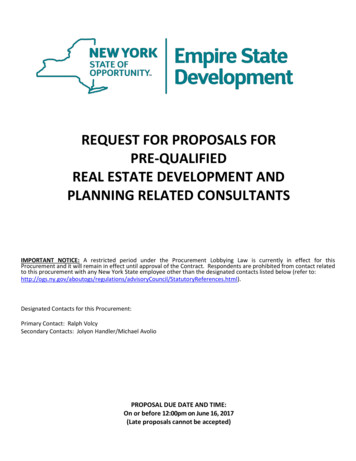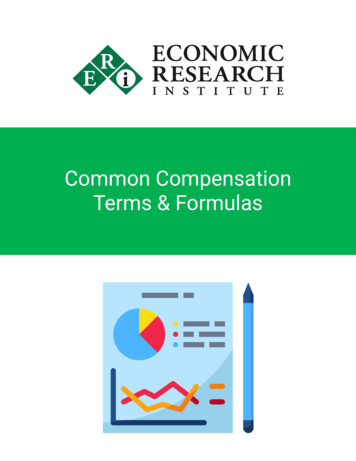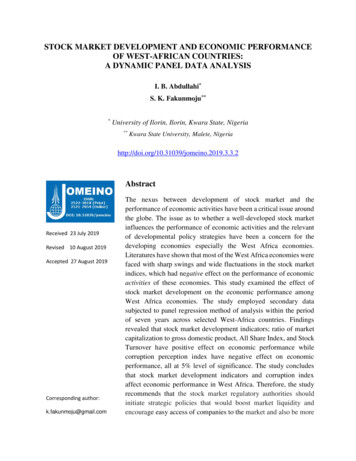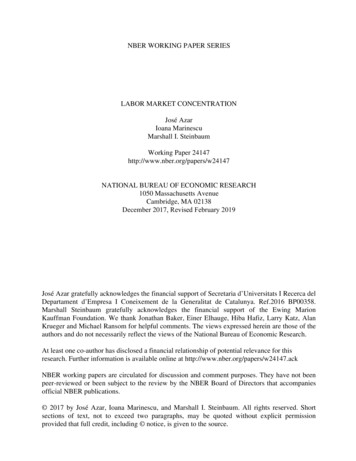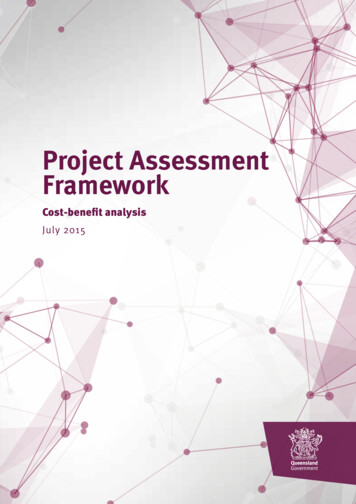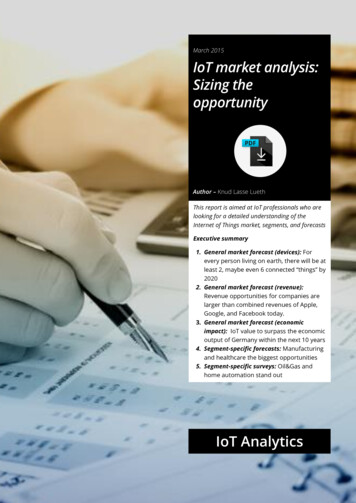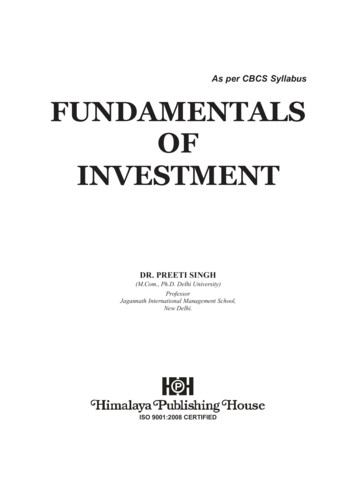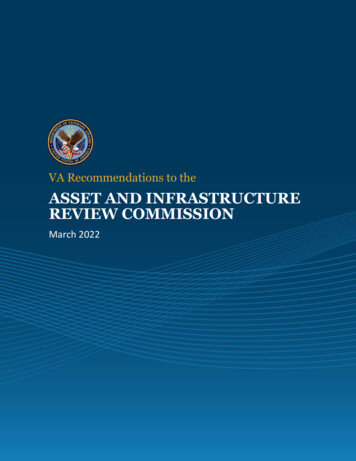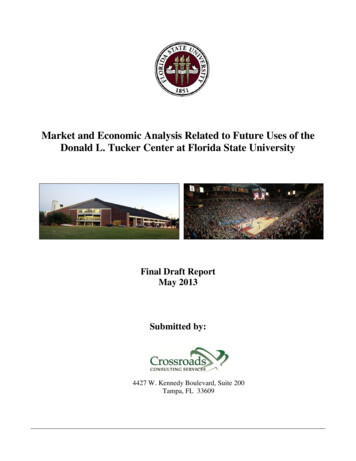
Transcription
Market and Economic Analysis Related to Future Uses of theDonald L. Tucker Center at Florida State UniversityFinal Draft ReportMay 2013Submitted by:4427 W. Kennedy Boulevard, Suite 200Tampa, FL 33609
May 30, 2013Mr. Cam Whitlock, PrincipalArchitects: Lewis Whitlock206 West Virginia StreetTallahassee, Florida 32301United States of AmericaDear Cam:Crossroads Consulting Services LLC is pleased to present this market and economic analysis as part ofthe overall master planning process for the Donald L. Tucker Center. In accordance with our agreement,this report summarizes our research and analysis which is intended to assist Florida State Universitywith its decisions regarding the future operations of the facility.The information contained in the report is based on estimates, assumptions, and information developedfrom market research, industry knowledge, input from potential demand generators, as well as otherfactors including data provided by Florida State University and other secondary sources. We haveutilized sources that are deemed to be reliable but cannot guarantee their accuracy. All informationprovided to us by others was not audited or verified and was assumed to be correct. Because theprocedures were limited, we express no opinion or assurances of any kind on the achievability of anyprojected information contained herein and this report should not be relied upon for that purpose.Furthermore, there will be differences between projected and actual results because events andcircumstances frequently do not occur as expected, and those differences may be material. We have noresponsibility to update this report for events and circumstances that occur after the date of this report.The accompanying report is restricted to internal use by Florida State University and may not be reliedupon by any third party for any purpose including financing. Notwithstanding these limitations, it isunderstood that this document may be subject to public information laws and as such can be madeavailable to the public upon request.Although you have authorized reports to be sent electronically for your convenience, only the final hardcopy report should be viewed as our work product.We have enjoyed serving you on this engagement and look forward to the opportunity to provide youwith continued service.Sincerely,Draft – subject to change4427 W. Kennedy Boulevard Suite 200 Tampa, Florida 33609 Phone 813.281.1222 Fax 813.315.6040www.crossroads-fl.com
Draft Document – Subject to ChangeTable of Contents1Introduction & Executive Summary2Market Overview123Historical Civic Center Operations184Competitive Environment265Input from Demand Generators296Comparable Facilities Analysis407Management Options468Renovation Cost Benefit Analysis51Table of Contents1
Draft Document – Subject to ChangeIntroduction and Executive SummaryIntroductionOriginally opened in 1981 and renovated several times over the years, the Donald L. Tucker Center(Civic Center) offers 12,200 seats for basketball, 34 luxury suites, 468 club seats and the Spotlight Grillrestaurant. There are three different components to the facility: the main arena, the 33,915 square foot(SF) exhibition hall and the terrace.The Civic Center is currently owned and operated by the Tallahassee-Leon County Civic CenterAuthority (Authority) which is governed by a 13-member Board. The Authority is an independentspecial district that was organized for the purpose of planning, developing, operating and maintaining acomprehensive complex of civic, governmental, educational, recreational, convention and entertainmentfacilities for the use and enjoyment of the citizens of the Tallahassee area. It does not have any taxingauthority and does not receive guaranteed funding from any entity including the City, County, and State.Historically, the City and the County mutually agreed to fund operating deficits up to a maximum of 125,000 each for a period of 40 years.In June 2012, the Authority and Florida State University (FSU) agreed to enter into an agreement for thetransfer of the Civic Center facility to FSU. This agreement will result in the transfer of all existingbank debt to FSU. In addition, FSU will assume full operational and financial responsibility of thefacility. The Authority and FSU entered into an agreement for a one-year leaseback of the property tothe Civic Center. The Authority released the City and the County from any further responsibility to payannual operating deficits. However, the City will continue to provide 60,000 annually toward the CivicCenter’s utility costs.As part of its agreement, FSU agreed to the formation of a community advisory board to ensure that thecommunity continues to have access to the property. From FSU’s perspective, this acquisition helps theCivic Center remain open and continue to host diverse events that benefit the community, allows theUniversity to host large scale events such as commencement and convocation and better serves themen’s and women’s basketball programs.Infrastructure demands, public accountability, changing economic conditions, tenant needs, marketingand sales opportunities, operational efficiencies, increasing competitive market and the growing demandfor quality services by event producers and attendees are factors that pose a continuous challenge topublic assembly facilities across the country.As part of its on-going planning efforts, FSU retained the project team of Architects: Lewis Whitlock,Populous and Crossroads Consulting Services LLC (Crossroads) to develop a master plan for the CivicCenter which identifies renovation/enhancement options that will increase the facility’s overallmarketability, competitiveness and financial performance. The master plan outlines recommendedphysical improvements to maintain the facility’s viability as a NCAA Division I basketball arena as wellas to meet the broader sports and entertainment needs of both the University and the community.1. Introduction and Executive Summary1
Draft Document – Subject to ChangeFSU’s specific goals for the Civic Center renovation include, but are not limited to: Providing a better fan experience. Enhancing revenue and sponsorship opportunities. Providing an innovative setting that complements other University facilities and initiatives. Assisting as a recruiting asset. Offering superior acoustics. Serving as the face of the University.The work plan included qualitative and quantitative analyses that focused on the unique attributes ofTallahassee, historical operations of the Civic Center, market supply relative to demand for the CivicCenter, potential demand segments, comparable facility operations, and cost/benefit analysis of futureenhancements.Crossroads was responsible for the market and economic analysis portion of the overall master plan.Our work plan included, but was not limited to, the following tasks: Conducting interviews and/or work sessions with key stakeholders including representatives fromFSU. Reviewing previous studies and documentation related to the project. Analyzing select market attributes including demographic/economic data; higher educationinstitutions; employment base; accessibility; lodging supply; existing facilities; and plannedamenities/developments that may impact future demand for the Civic Center. Analyzing historical operating data for the Civic Center. Conducting interviews with existing and potential user groups including representatives from FSUathletics; area scholastic programs; State, regional and national youth and amateur sportsorganizations; event producers of various special athletic events; concert promoters; consumer showpromoters; family show promoters; as well as community/civic organizations. Analyzing operating data from comparable facilities. Commenting on the programmatic and supporting infrastructure recommendations from a marketperspective in order to better address potential target markets and accommodate multi-purpose eventneeds. Summarizing estimated project costs of the recommended renovations/enhancements and theirassociated return on investment relative to achieving FSU’s stated objectives for the Civic Center.The remainder of this report presents the findings and principal conclusions from our research.1. Introduction and Executive Summary2
Draft Document – Subject to ChangeExecutive SummaryThe following provides an executive summary of the study’s findings. The detailed analysis can befound in the sections that follow.Market OverviewAn area’s demographics play a key role in its marketability for various activities. In 2012, thepopulation of Leon County (the primary market area) was nearly 280,000 compared to approximately373,000 within the four-county Core Based Statistical Area (the secondary market area). Between 2012and 2017, the population within both the primary and secondary markets is projected to experienceminimal growth – an average annual increase of less than 1.0%. The median household income isapproximately 43,000 in both the primary and secondary markets.Tallahassee is home to several colleges and universities that are significant economic generators in thecommunity. The students, faculty, staff and visitors at these institutions represent a target market for theCivic Center.The overall strength of the economy, diversification and size of local businesses as well as competitionfrom other existing facilities are factors that can impact premium seating sales, advertising, corporatesales and season ticket support. Approximately 30% of employment in the Tallahassee CBSA isgovernment-related. The State of Florida (non-university) has nearly 31,000 employees followed byFSU with 6,450 employees and Leon County schools with 4,450 employees. As of January 2013, theannual unemployment rate for Leon County was 6.7%, which was lower than that for the State ofFlorida (7.8%) and the U.S. (7.9%). Tallahassee’s existing reputation for higher education and Stategovernment-related business provide an opportunity for the community to retain and/or capture more ofthose visitors via an enhanced Civic Center.Vehicular accessibility along I-10 presents opportunities to draw attendees from throughout the Stateand the region. In addition, the Tallahassee Regional Airport is an asset that can be beneficial inattracting attendees and support personnel to certain events, particularly for those people who may onlyattend a portion of the event.The diversity and supply of hotel rooms proximate to the Civic Center can be an important factor inattracting events, accommodating attendees and generating room nights. Tallahassee has 64 hotelproperties that offer more than 5,800 hotel rooms. Although the lodging supply is diverse, availability isimpacted by factors such as the State legislative session and special events held at FSU and other areainstitutions.Historical Civic Center OperationsThe mission of the Civic Center is to operate an exceptional facility offering world class entertainmentand quality meeting space for the enrichment of the community and region. It strives to provide a safeand comfortable environment with the highest degree of service and professionalism. As such, the CivicCenter hosts a variety of event activity with varying space needs and demands for amenities/supportservices.1. Introduction and Executive Summary3
Draft Document – Subject to ChangeThe Civic Center has averaged 514 events and nearly 394,000 attendees annually over the past threefiscal years which provides a solid base of future business. Event activity has generally been fairlyconsistent over the past three fiscal years with the exception of a decline in food functions andmeetings/lectures/seminars.Over the last three years, food functions have averaged 70% of total events but only 13% of totalattendance. Sporting events and graduations have accounted for 34% and 16% of total attendance,respectively. Graduations have averaged nearly 9,200 people over the last three years followed byconcerts (3,700), family shows (3,400) and sporting events (3,200), respectively. Between FY 2009 andFY 2012, FSU men’s basketball averaged nearly 8,200 per game and FSU women’s basketball averagedalmost 2,700 per game. Other than graduations, very few events require the Civic Center’s maximumcapacity.An analysis of lost business reports for calendar year 2012 indicates that the amount/type/availability ofspace at the Civic Center was not a primary reason for lost business. As such, increasing seatingcapacity or the amount of exhibit space does not appear to be an immediate need for the Civic Center.According to the audited financial statements, the Civic Center has averaged operating income ofapproximately 337,000 between FY 2009 and FY 2011. Food/beverage accounted for 30% ofoperating revenue followed by reimburseable expenses (20%) and suite/club seat revenues (16%) duringthe profiled period.Only 68% of the suites are sold indicating limited demand for the product which is likely attributable tofactors such as employment base and general economic conditions.In FY 2012, FSU basketball accounted for 15% of total Civic Center revenues. Concessions comprisedmore than 70% of FSU basketball-related revenues. As such, future improvements should seek tofurther enhance the marketability of concessions areas.Concerts represented approximately 49% of non-FSU arena revenues followed by family shows (27%)and Broadway shows (12%). The profit margin per event averaged 90,000 for family shows and 81,000 for concerts. Future improvements should seek to further enhance the marketability andprofitability of these event types.Relative to financial performance, it is important to recognize that the University is performing on-goingdue diligence relative to historical financial reporting for the Civic Center. As such, some adjustmentsmay ultimately be made to historical figures which could impact the findings of this report.Competitive EnvironmentThe existing supply of area facilities is relatively limited. There are no competitive arenas locatedwithin 150 miles of Tallahassee other than FAMU’S Lawson Center, which is primarily dedicated touniversity-related activity.1. Introduction and Executive Summary4
Draft Document – Subject to ChangeTwo new, smaller entertainment facilities are in the development stages that will offer unique settingsfor more intimate entertainment acts. Cascade Park is a joint City/County amphitheater project that isslated to open later this year. Current plans call for approximately 1,500 fixed and 2,500 lawn seats. Anew nightclub/restaurant is being planned by Live Nation as part of the College Town developmentwhich is anticipated to accommodate 2,000 people. Stakeholders view these new entertainment venuesas complementary to the Civic Center based on their program elements and target markets and suggestedthey would further enhance the area’s ability to draw more, diverse entertainment acts.Tallahassee also offers several meeting/banquet venues including special event facilities and hotelswhich primarily host conventions, conferences, tradeshows, meetings, banquets and smaller exhibitions.FSU offers three of the four largest meeting/banquet facilities. Although the Civic Center’s size allowsit to accommodate relatively large groups, its amenities and technology are challenges for attractingcertain groups. These limitations will likely become more prominent when the University assumescomplete ownership/operation of the Civic Center given the high-quality features offered at its otherassets.The Civic Center’s seating capacity for basketball is consistent with the median (12,500) for arenas thatcurrently or soon will host ACC men’s basketball teams. Several of the ACC arenas are significantlylarger than the Civic Center because they serve other purposes (e.g., host collegiate football orprofessional sports) or they have a historically strong men’s basketball program. In addition, the CivicCenter offers significantly more suites than the average or median of ACC arenas.Input from Potential Demand GeneratorsThe primary tenant at the Civic Center will continue to be the FSU men’s and women’s basketball teams.FSU men’s and women’s basketball have not historically been restricted by the Civic Center’s seatingcapacity. However, some desired improvements may achieve broader University goals (e.g., providing afirst-class recruiting tool, becoming the face of the University, etc.) that may not directly result inincreased usage or improved financial performance at the Civic Center.Input was also obtained from existing and potential users in order to identify potential unmet demand andrequired program elements. Promoters of both arena events and meeting/exhibition events are generallypleased with customer service, food/beverage service, the facility’s downtown location, and proximity toFSU. Promoters also noted that the new ownership presents unique and positive opportunities to leveragemedia for their event activity.Consolidation of venues and live entertainment combined with economic pressures on ticket buyers hascreated a very competitive environment for attracting concerts, family shows, Broadway shows and othersimilar spectator events. Arena event promoters noted the Civic Center’s age and lack of modernaesthetics as challenges. That said, representatives suggested that any future physical improvements takeinto account the following: the amount, proximity and pricing of parking; maintaining the current amountof floor space; and providing sufficient backstage and dressing room areas.1. Introduction and Executive Summary5
Draft Document – Subject to ChangeAccording to industry publications, there were 331 State/Regional and 231 National trade and professionalassociations headquartered in Florida in 2011 which provide a target market for the Exhibition Hall andMeetings Rooms. Meeting and exhibition event planners cited lack of sufficient parking, distance ofparking from venue, columns in the Exhibition Hall, lack of modern technology, and antiquated lightingsystem as physical challenges.Both arena and meeting/exhibition promoters indicated that factors such as market size, ticket sales,average ticket price realized, cost to utilize the facility, and overall support for events would impact theirfuture decision regarding whether to play the facility/market rather than the physical building program.Comparable Facilities AnalysisIn order to assist in evaluating the types of renovations/enhancements necessary for the Civic Center toremain competitive, operating data from select new/renovated Division I arenas was analyzed. Like theCivic Center, five of the 11 profiled facilities serve as the primary arena in the market. While nine ofthe 11 (82%) profiled facilities are University-owned, only four are University-operated. The otherseven arenas are operated by private management companies. Although the Civic Center offers thesame seating capacity as the average of the peer facilities, it has significantly more suites and less clubseats as profiled facilities.As a point of reference, Georgia Tech reopened its arena in 2012 after a 50 million retrofit. The formerAlexander Memorial Coliseum was renamed the McCamish Pavilion after a donor who gave 15 millionto help finance the renovation. Major changes included reducing the seating capacity from 9,200 to8,600; reconfiguring the seating bowl to one that mirrors the court rather than the original circularseating pattern; removing the 12 suites to provide space for a sideline club seat section; and providingimproved courtside seating. The facility also removed a concourse wall in order to provide a more openview of the court from the concourse and installed theatrical lighting.Profiled peer arenas hosted an average of 210 events and 566,900 in total attendance. Utilization isimpacted by factors such as the physical product, market characteristics, accessibility, missionstatement, booking policy, rental and labor rate structure, regionally competitive facilities, marketingefforts and general economic conditions. The Civic Center hosted more events than all of the profiledpeer facilities but 30% fewer total attendees than the average of the profiled set.One of the driving forces of an arena’s seating capacity is concert and other commercial activity whichcan generate substantial revenue. Some arenas can reduce their seating capacity through the use ofcurtaining. An analysis of event statistics from 2012 Pollstar reports, an industry resource that tracksbox office statistics at facilities for available acts, further supported the cost consciousness of theTallahassee market relative to entertainment events.A comparison of select financial operations at the profiled peer facilities indicated that the Civic Centerranked fourth among the profiled facilities in terms of operating gain/loss. Based on audited financialstatements, the Civic Center realized an operating gain of 246,000 in FY 2011 while the profiledfacilities ranged from an operating gain of 711,000 to an operating loss of 1.0 million.1. Introduction and Executive Summary6
Draft Document – Subject to ChangeManagement OptionsThere are several potential management options for arena/civic center facilities including operating as anindependent authority; operating through traditional governmental management such as a City/Countydepartmental structure; operating as a University department; or contracting with a third party thatspecializes in managing similar facilities. The management approach is important because it typicallyimpacts all aspects of operations including marketing, utilization, financial operations and overallefficiency of a facility. For instance, some publicly run facilities are limited in their capability to act asquickly as other management approaches. In addition, there is typically pressure on university assets tooperate with a high degree of fiscal responsibility.As such, some facilities owners choose to delegate the management of facility operations to some formof third party that provides industry knowledge and representation. In addition to these benefits,management through a third party can offer stability and insulation from political influence which canbe desired attributes by customers, vendors, facility management and staff who typically prefer acontinuity of purpose and ability to function within a business environment that is not affected by eachpolitical election.Approximately 64% of the profiled peer facilities are privately operated. University facilities that alsoserve as the primary sports/entertainment venue in the community and/or want to maximize nonuniversity event activity are increasingly choosing to contract with a private management company.Examples of privately operated facilities include BankUnited Center, Chaifetz Arena, Ford Center, JohnPaul Jones Arena, KFC Yum! Center and PNC Arena.As FSU continues to evaluate future operations of the Civic Center and prioritize potential renovations/enhancements, it should assess which ownership and/or management approach best meets its long-termobjectives for the facility. Moving forward, the Civic Center needs to be operated in a first-class mannerby an aggressive, experienced management team with strong industry contacts in order to enhance itsmarketability and competitiveness.Potential benefits of operating the Civic Center through a third party management company ratherthan as a university department include, but are not limited to, providing greater latitude in staffing,compensation, contracts and incentive pay; increasing revenue generating potential; providingfinancial transparency, accountability and reporting; and allowing for greater autonomy while stillbeing funded by public and private sources. In addition, there may be an opportunity to obtain somelevel of capital support as part of the management agreement which is typically accomplished througha one-time capital improvement contribution and/or a dedicated event marketing fund.One common apprehension for universities considering third party management is losing control ofthe asset. However, third party management is an agent of the university charged with managing andpromoting the asset. As such, the university can manage the amount and type of control that it retainsthrough the terms of its management agreement. For instance, in most private managementagreements, universities still retain ownership; approve the operating and capital budgets; provideinput and direction regarding policy; receive regular financial and management reports; and have theability to terminate the management company for cause. Typically, universities are actively involvedin the hiring and/or approval of the facility’s general manager and have a designated contract1. Introduction and Executive Summary7
Draft Document – Subject to Changeadministrator that oversees the terms of the contract and serves as liaison between the university andthe management company.As all ownership, operational and financial responsibilities of the Civic Center transition to theUniversity; it is recommended that the University strongly evaluate the merits of third partymanagement in order to maximize utilization, marketability and financial performance. Thisrecommended management approach is based on trends in the industry, the unique nature of the asset,and the University’s stated objectives for the Civic Center.Market Demand for Recommended Civic Center ImprovementsThe Civic Center has fallen behind its competitive set in terms of overall condition and patron amenities.In addition, deferred maintenance is taking a toll throughout the Civic Center. Based on variousresearch and analysis including a comparison of peer arenas at peer institutions and discussions andextensive feedback from representatives at FSU and other stakeholders, Populous prepared a detailed listof optimal building/renovation program recommendations by major area as compared to the existingCivic Center. Market research supported these recommendations, particularly relative to achieving thedesired long-term goals of the University and the broader community.Potential Impact of Remaining Status QuoIf the facility is not improved, remaining status quo relative to capital funding will likely result in adecrease in event activity over time that yields an operating loss. The table below compares the CivicCenter historical three-year average to the estimated status quo in key metrics.CategoryComparison of Historical Three-Year Average toEstimated Status Quo Scenario at Civic CenterHistorical ThreeYear AverageEventsEvent DaysTotal Attendance514588393,958Incremental Impact to Event ActivityEventsEvent DaysTotal AttendanceOperating RevenuesOperating ExpensesOperating Gain/(Loss)Expense Coverage RatioIncremental Impact to Financial OperationsOperating RevenuesOperating ExpensesOperating Gain/(Loss)Status Quo508564365,675-1%-4%-7% 7,016,000 6,679,000 337,000 6,624,000 6,749,000( 125,000)105%98%-6%1%-137%Notes: Status quo assumes no increase in capital funding over historical levels.Expense coverage ratio operating revenues/operating expenses.Operating expenses do not include taxes, debt service or depreciation.Historical three-year average data was provided by Civic Center managementand audited financial statements.1. Introduction and Executive Summary8
Draft Document – Subject to ChangeRecommended Civic Center ImprovementsThe project team developed a list of recommended needs from both a physical/facility perspective andfrom a competitive market perspective. These needs are based on our project team’s observations of thefacility and its operations; conversations with current, former, and potential users of the facility; thecompetitive/comparable facility assessment; as well as input from FSU representatives.Populous developed a prioritized statement of needs that addresses the key points of our project team’sanalysis. The statement of needs includes associated order-of-magnitude cost estimates for each lineitem so that the overall quantitative and qualitative financial return can be evaluated.Recommended facility improvements were grouped into the following categories that relate to theUniversity’s stated goals for the master plan of the Civic Center as well as their relative cost andimplementation timeframe:Base level improvements include recommendations that seek to create a better fan experience, assist as arecruiting asset, improve acoustics and position the Civic Center in a better position to become the faceof the University. As stated previously, some of these renovations/enhancements relate to requireddeferred maintenance and infrastructure improvements that would ideally be addressed within the nextone to two years in order to enhance marketability and competitive position from both the patron and theevent promoter perspective.Intermediate level improvements focus on those improvements that can enhance revenue andsponsorship opportunities (e.g., suite and club level improvements) as well as those that address backof-house needs.Advanced level improvements represent a more ambitious set of facility changes that could help positionthe Civic Center for longer-term success in the marketplace. These changes involve significant upgradesto the building exterior (e.g., a new lobby addition) and/or repurposing of existing space (e.g., newmeeting rooms/prefunction improvements).Stand-alone improvements including expansion of the basketball practice facility and the Phase II sitedevelopment can be completed at any time.Cost estimates for this report were developed by Rider Levett Bucknell (RLB), professional costestimators and cost consultants. The cost estimates reflect total project costs including both hardconstruction costs as well as soft costs such as design fees, testing, and contingency fees. Further, thesecosts reflect the value of the improvements in 2013 and do not
In June 2012, the Authority and Florida State University (FSU) agreed to enter into an agreement for the transfer of the Civic Center facility to FSU. This agreement will result in the transfer of all existing bank debt to FSU. In addition, FSU will assume full operational and financial responsibility of the facility.

